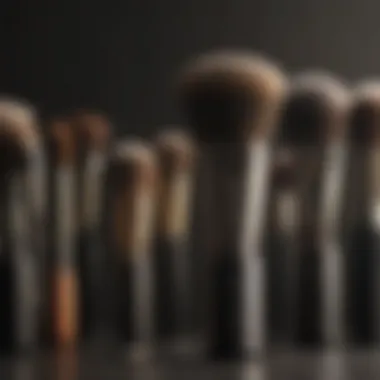Choosing the Ideal Foundation Brush for Liquid Makeup


Intro
Choosing the right foundation brush for liquid foundation is essential for achieving a flawless finish. While many aspects of makeup application, such as skincare, color selection, and accuracy of technique, contribute to overall results, the tools used can significantly enhance or detract from the desired outcome. This article provides a detailed guide on selecting an appropriate foundation brush, understanding types, features, and applying optimal techniques. We will also explore maintenance practices and common troubleshooting tips to elevate your liquid foundation experience.
Fashion Trends
When it comes to selecting a foundation brush, understanding current fashion trends can influence choices. Makeup trends vary with seasons, from dewy summer looks to heavier foundations during colder months. Women of all ages may find inspiration in the latest styles, showcasing their unique preferences.
Seasonal Styles
The role of foundation brushes evolves as makeup trends shift through various seasons. For instance:
- Spring/Summer: Lightweight, airy textures are preferable. Brushes that apply liquid foundation seamlessly, like the flat top kabuki, are popular.
- Fall/Winter: Coverage is essential. A dense brush that provides fuller coverage can help in achieving the perfect canvas before applying other products.
Influencer Inspirations
Social media plays a crucial role in shaping foundation application techniques. Influencers often share their routines, demonstrating different types of foundation brushes and their effectiveness. By following industry experts, one can gather ideas on how to use these tools for optimal results.
"The right brush can make all the difference in achieving a flawless foundation look."
Beauty Tips
Understanding how to use a foundation brush properly is key to successful application. Equally vital are skincare routines that prepare the skin for makeup.
Skincare Routines
Proper skincare is the foundation of great makeup. Consider the following routine:
- Cleanser: Begin with a gentle cleanser to remove impurities.
- Moisturizer: A hydrating moisturizer helps create a smooth surface.
- Primer: Using a primer can enhance the application of liquid foundation, allowing for better durability throughout the day.
Makeup Techniques
Technique can vary based on brush type; it is essential to know how to manipulate your tool effectively. Here are some popular techniques:
- Buffing: Using circular motions to blend foundation seamlessly.
- Stippling: Lightly tapping the brush to build coverage without streaks.
Product Reviews
In exploring foundation brushes, product reviews can provide valuable information for making informed choices. Understanding trending options helps to pinpoint brushes that align with personal preferences and makeup needs.
Trending Products
Some of the popular foundation brushes currently include:
- Real Techniques Expert Face Brush: Known for its versatility and affordability.
- Morphe M439 Deluxe Buffer Brush: Ideal for achieving a full coverage look.
- IT Cosmetics Heavenly Luxe Flat Top Buffing Foundation Brush: Offers luxury quality with an effective design.
Comparison Guides
When selecting a foundation brush, it helps to compare their features. Consider factors like bristle density, shape, and texture. Some brushes work better for liquid formulations, while others are more suited for creams or powders.
The End
The art of choosing a foundation brush for liquid foundation involves evaluating personal preferences, skin type, and makeup goals. With knowledge about trends, techniques, and available products, anyone can enhance their makeup application and achieve a polished look.


Prelude to Foundation Brushes
Choosing the right foundation brush is crucial for achieving an impeccable makeup look. In the realm of liquid foundations, the type of brush utilized can greatly influence the final appearance. Makeup application is an art form, and brushes are the essential tools that enable the artist to create a flawless finish. Understanding foundation brushes is the first step toward mastering this art.
Whether applying a light layer for a natural look or building up coverage for a more dramatic effect, the brush is a key player in the process. The appropriate brush can enhance the blending of liquid foundation and promote a smooth, even application. On the other hand, a poor choice can lead to streaks or patches, ruining the overall effect. Therefore, gaining knowledge about foundation brushes is not just beneficial but essential for anyone who wishes to elevate their makeup skills.
Defining Foundation Brushes
Foundation brushes are specialized tools designed to apply foundation products onto the skin with varying techniques and styles. They come in a myriad of shapes, sizes, and bristle materials. The type of brush used can define the finish, coverage, and ease of application. For instance, flat brushes provide a smooth canvas, whereas buffing brushes can deliver a more blended and polished look.
Understanding the distinction in foundation brush designs helps in selecting the one that best suits individual needs. Each brush offers different functionalities. Consequently, it is imperative to know the specifications to ensure that you choose correctly.
Importance of Choosing the Right Brush
Choosing the right brush for liquid foundation can have a profound impact on your makeup results. The correct brush will not only facilitate seamless application but also enhance the longevity of the foundation. High-quality brushes can prevent the premature breakdown of makeup while ensuring skin appears radiant and fresh.
Additionally, the appropriate brush can affect how the foundation interacts with the skin. For example, a brush with natural fibers may apply foundation differently than a synthetic one. Being aware of such factors is critical to making an informed choice. Remember that investing time to understand and select the best brush for liquid foundation can significantly improve the overall makeup experience.
"The right tools can make all the difference in your foundation application."
By focusing on specific characteristics and user preferences, this article endeavors to help readers navigate the complex world of foundation brushes. This understanding is not just for cosmetic enthusiasts but anyone who values precise and effective makeup application.
Types of Foundation Brushes
Choosing the right type of foundation brush is crucial for achieving a flawless liquid foundation application. Each brush type offers specific benefits that can affect the overall finish and ease of application. Understanding these different types will help users make an informed decision tailored to their personal makeup preferences. The main categories of foundation brushes include flat, round, buffing, and stippling brushes, each serving distinct purposes that can enhance the makeup experience.
Flat Foundation Brushes
Flat foundation brushes feature a wide, flat head that can provide an initial layer of coverage. These brushes are designed to smoothly glide liquid foundation over the skin. They are especially effective for achieving a more natural look by distributing foundation evenly. The tight bristles help in minimizing streaks, making them suitable for one-layer applications. To use, apply foundation onto the brush and use sweeping motions to cover the face.
Using a flat foundation brush is ideal for those who prioritize speed in their application process. Its design makes it easy to reach difficult areas, like around the nose and under the eyes. However, it may not be as effective for blending as other brush types, which could lead to a less seamless finish if not used correctly.
Round Foundation Brushes
Round foundation brushes are characterized by their dome-shaped heads. They are versatile tools that allow for both stippling and buffing techniques. When applied in circular motions, a round brush can push the foundation into the skin, providing increased coverage and a natural blend. This type of brush is beneficial for those who want a more polished finish.
They can easily adapt to the contours of the face, providing excellent coverage on the cheeks and forehead. However, round brushes may require a bit more technique and practice to master. Users might find that they need to work in smaller sections to ensure that the foundation blends smoothly, taking a bit more application time compared to flat brushes.
Buffing Brushes
Buffing brushes are densely packed, often featuring short bristles designed for blending and finishing techniques. The main benefit of a buffing brush is its ability to create a seamless, airbrushed effect. Ideal for those using liquid foundation, these brushes can be used in circular motions or back-and-forth for a thoroughly blended finish.
The design of buffing brushes allows for building coverage gradually, which is particularly useful for users desiring a sheer or full coverage look over time. The soft bristles feel gentle against the skin and help prevent product buildup, making them suitable for daily use. Keep in mind that a buffing brush may not be the best option for those who prefer a faster makeup routine, as it requires some effort to achieve full coverage.
Stippling Brushes
Stippling brushes have two lengths of bristles—short and long—helping to create an airbrushed finish. The technique involves lightly dabbing the brush on the skin, allowing for less product transfer and more natural-looking coverage. This is especially advantageous for users who wish to avoid a heavy makeup appearance.
The stippling method can be especially helpful for achieving a dewy finish, as it allows for the liquid foundation to blend more seamlessly with the skin's natural texture. However, mastering this technique requires practice to avoid uneven coverage. Stippling brushes can be a great choice for those who enjoy a softer, more blended look without a lot of effort.
Criteria for Selecting a Foundation Brush
Selecting the right foundation brush can significantly enhance the finish of your liquid foundation. The right brush contributes to even application, blending, and the overall look of your makeup. Several criteria come into play when making this choice. Understanding these elements helps you to achieve a more polished appearance.


Bristle Material
The bristle material is perhaps one of the most crucial factors to consider. The choice between synthetic and natural fibers affects how the brush interacts with your foundation and your skin.
Synthetic vs. Natural Fibers
Synthetic brushes are typically made from nylon or polyester. They are a beneficial choice for liquid foundations as they tend to be less absorbent, ensuring that more product stays on the skin. They are also durable and maintain their shape well over time. This type of brush is ideal for an airbrushed finish, which is often desired in liquid foundation application.
In contrast, natural fiber brushes, made from animal hair, can provide a softer feel on the skin. They are excellent for powder formulations but can absorb liquid products, causing wastage. While they may provide a seamless finish, their upkeep requires more attention, especially regarding hygiene and texture.
Sensitivity Concerns
Sensitivity is another important factor to think about. Those with sensitive skin may need to be cautious when choosing a brush. Some natural fiber brushes can sometimes cause irritation, depending on the source of the hair. Synthetic brushes often provide a hypoallergenic option, as they can be made with non-allergenic materials that are friendly on sensitive skin. Finding a brush that caters to skin sensitivity will promote comfort during application and maintain skin health.
Brush Size
Brush size is critical to how your foundation applies. Different sizes serve distinct purposes.
Full Face vs. Targeted Application
A larger brush can cover a bigger area quickly, making it suitable for full-face application. However, this might lead to less control in areas that require precision, like under the eyes or around the nose. Conversely, smaller brushes are excellent for targeted application, allowing you to blend seamlessly. They are beneficial for detailed work, especially when building coverage in specific areas. A balanced approach may involve using both sizes for various applications, enhancing your overall makeup experience.
Handle Design
The handle design impacts how comfortable it is to use the brush during application.
Ergonomics and Comfort
A well-designed handle can improve grip and control. Ergonomics play a key role in ensuring that you don't tire your hand during application. A comfortable handle allows for better maneuverability and consistent strokes, which is vital when trying to achieve even coverage. Choosing a handle that feels right in your hand will enhance your overall experience with the brush. For many users, the right handle can make the difference between an effortless application and a cumbersome one.
"Investing in a good-quality foundation brush enhances the application process, making your makeup last longer and look better."
Best Practices for Application
Applying liquid foundation is a nuanced process that can greatly influence your final makeup look. Best practices for application ensure that the foundation sits well on the skin, achieving a seamless finish. These practices emphasize proper preparation, effective techniques, and the necessary adjustments to cater to individual skin types and preferences. Establishing a consistent routine can make a significant impact on your makeup application experience, allowing you to maximize the benefits of your selected foundation brush.
Preparatory Steps
Before applying liquid foundation, preparatory steps are crucial. This ensures that your skin is in the best condition to receive makeup. Start by cleansing your face to remove impurities. Following this, apply a suitable moisturizer that aligns with your skin type, whether oily, dry, or combination. Furthermore, using a primer can help create a smooth base. A well-chosen primer not only enhances foundation longevity but also improves the overall appearance. It can address specific concerns like oil control or hydration.
Application Techniques
Buffing
Buffing is a technique characterized by circular motions which blend makeup seamlessly into the skin. This method is particularly effective for achieving a polished finish. The key characteristic of buffing lies in its ability to build coverage gradually. It is a popular choice because it provides an opportunity to layer without looking cakey. The unique feature of buffing is that it softens the appearance of imperfections. However, one must be careful not to over-buff, as it can disturb the skin's natural texture and lead to patchiness.
Stippling
Stippling involves the use of a bounce-like motion to apply foundation. This technique is beneficial for creating a light, airy finish that mimics the skin's natural glow. The primary characteristic of stippling is its versatility; it can work well for both full coverage and sheer applications. Its unique feature is the inclusion of more air in the application process. This can be an advantage for those seeking a more natural look, but it may require a bit more product for full coverage, which some might view as a disadvantage.
Swiping
Swiping is the most straightforward technique, involving a simple back-and-forth motion. This method works well for quick applications, making it a favorite among those who value efficiency. The key aspect of swiping is its speed; it allows for rapid coverage. However, the downside is that it may lead to streakiness if not executed carefully. To mitigate this, it’s essential to use a foundation brush with good quality bristles that distribute product evenly.


Achieving an Even Finish
Achieving an even finish is the ultimate goal of using a foundation brush. The effectiveness of any application technique relies on proper blending and distribution. Additionally, paying attention to skin preparation and using the right products can greatly influence the outcome. Regularly cleaning your brushes is also important; it ensures the bristles perform well and maintains skin health. When you implement these practices, your foundation not only looks better, but it also lasts longer throughout the day.
Maintenance of Foundation Brushes
Maintaining foundation brushes is essential for achieving impeccable makeup application. Proper upkeep not only prolongs the life of the brush but also ensures that the makeup applied is hygienic and free from contaminants. Brushes harbor bacteria, oils, and makeup residue, which can lead to skin issues if not properly cared for. Regular maintenance can significantly improve the performance of the brush and the overall result of liquid foundation application.
Cleaning Techniques
Frequency of Cleaning
The frequency of cleaning foundation brushes is an important consideration. Ideally, brushes used for liquid foundation should be cleaned after each use. This practice prevents buildup of makeup and bacteria. For brushes used less frequently, it is recommended to clean them at least once a week. This routine is beneficial because it not only removes product residue but also ensures that the bristles remain soft and supple.
A key characteristic of frequent brush cleaning is that it contributes to skin health. Brushes that are not regularly cleaned can cause breakouts or irritation. Unique to this frequency is the immediacy with which cleanliness can affect makeup application. Many users notice a more flawless finish when using freshly cleaned brushes. However, a potential inconvenience is the time investment required to clean and dry the brushes regularly, which can be challenging for those with a busy schedule.
Effective Cleaning Products
Effective cleaning products play a vital role in maintaining the integrity of foundation brushes. There are various products designed specifically for cleaning makeup brushes. Popular options include gentle liquid soap, brush cleansers, and makeup remover that are suitable for removing liquid foundation without damaging the bristles. One key characteristic of these products is their ability to effectively dissolve makeup residues while being gentle on fibers.
These products usually come with unique features such as antibacterial properties, which further enhance their efficacy in eliminating bacteria. A significant advantage of using effective cleaning products is that they ensure a thorough clean, contributing to longer-lasting brushes. However, some commercial brush cleansers can be costly, which may deter some users from choosing them. Additionally, not all cleaning solutions are suitable for all types of bristles, so caution is necessary.
Storage Solutions
Proper storage solutions are crucial for maintaining foundation brushes. When brushes are stored correctly, they retain their shape and bristle strength. Using a brush holder or a simple makeup bag can protect brushes from dust and damage. Storing brushes upright is advisable; this keeps the bristle heads from getting misshaped. Additionally, avoiding overcrowding in storage prevents damage from bristles rubbing against each other. Investing in a quality brush case can yield long-term benefits by protecting both the brushes and the investment made in them.
Troubleshooting Common Issues
Selecting the right foundation brush can greatly enhance your makeup application process. However, it is essential to recognize that even the best tools can sometimes lead to issues. This section addresses common challenges encountered with foundation brushes when applying liquid foundation. Understanding these issues can save you time, improve your makeup results, and help maintain your brushes for longer use. The following subsections deliver insights into patchy application, brush shedding, and skin irritation, providing helpful solutions to each problem.
Patchy Application
A patchy application often stems from improper technique or an unsuitable brush choice. When using a brush not designed for liquid foundation, the product may not spread evenly. This can lead to an unattractive, uneven finish on the skin. To combat this, consider the following points:
- Choose the Right Brush: Opt for brushes specifically made for liquid application such as buffing or stippling brushes.
- Apply in Layers: Start with a small amount of foundation, applying in thin layers. Gradually build coverage rather than using too much product at once.
- Technique Matters: Use light, circular motions to help the foundation blend seamlessly into the skin.
"Makeup application is as much about technique as it is about tools. Choosing a suitable brush and using the right method can be a game-changer."
Brush Shedding
Another common issue faced by many users is brush shedding. This can occur due to the bristles' quality or can be exacerbated by improper cleaning techniques. Shedding not only reduces the brush's effectiveness but also introduces stray hairs to your makeup. Here are some strategies to minimize shedding:
- Quality Over Cost: Investing in a high-quality brush can often prevent shedding. Natural bristle brushes may shed more than synthetic ones, but they provide great results when maintained properly.
- Cleaning Method: Regular cleaning can help maintain the integrity of the bristles. Use gentle, dedicated brush cleaners rather than harsh soaps.
- Storage Solutions: Store your brushes upright to prevent pressure on the bristles. Avoid letting them sit with bristles touching surfaces.
Skin Irritation
Skin irritation can significantly impact your makeup experience, making it crucial to address the potential triggers. Different factors can contribute to irritations, such as brush material, residue from previous products, or pressure applied during application. Consider these tips to avoid skin issues:
- Choose the Right Materials: If you have sensitive skin, opt for synthetic brushes. These tend to be softer and hypoallergenic.
- Keep Brushes Clean: Accumulated product and bacteria can lead to skin irritation. Clean your brushes regularly to maintain hygiene.
- Mind the Pressure: When applying foundation, apply it with light pressure. Too much force can cause irritation and unevenness in application.
Epilogue
In the realm of makeup application, selecting the right foundation brush holds significant importance. This article has outlined the various factors that contribute to an effective choice. From understanding the different types of brushes to recognizing the nuances in bristle materials, every detail plays a role in achieving a flawless finish with liquid foundation.
Choosing the best brush means enhancing the efficacy of your makeup routine, ensuring that application is seamless and even across the skin. Not only can an appropriate brush improve the way your foundation blends, but it can also help in minimizing skin irritation, especially when the right materials are utilized. It is equally essential to consider your unique skin type and personal preferences when making this decision.
Final Thoughts on Choosing a Foundation Brush
Ultimately, the right foundation brush is a personal choice influenced by technique, comfort, and desired finish. Whether one prefers a synthetic bristle for a smoother effect or a natural option for better blending, the effect of this decision resonates throughout one's makeup experience. As with many aspects of beauty, experimentation is key. Taking the time to try different brushes can bring clarity to individual preferences and needs.
"A well-chosen foundation brush can transform not only your makeup application but also your confidence in your look."
Reflect on the points discussed in this article and choose wisely. This small but crucial decision can make a substantial difference in your overall makeup artistry.



